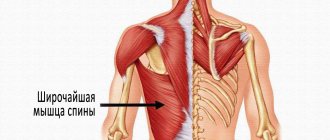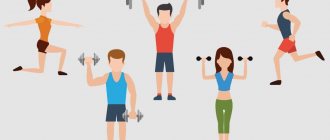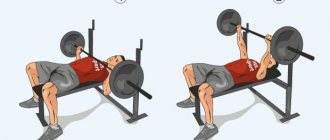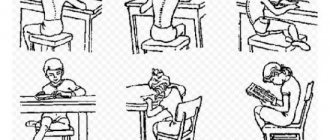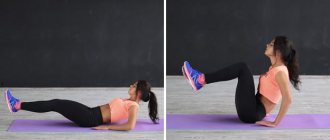Stretching rules
You can perform the exercises that we have selected in this article on your own and stretch absolutely all muscle groups. The time will be about 60-90 minutes. If you want a smaller workout, choose 2-3 exercises from each muscle group.
Each exercise should be performed for approximately half a minute to 2 minutes. The exercises should be performed smoothly, no sudden movements that can only cause harm. Neck muscle stretch
Head tilt to the side
Tilt your head to the left, placing your left hand on your head to apply more tension to the muscles, but do not overdo it. Repeat the same on the right side.
Head tilts forward and backward
Now tilt your head back, stretching the front muscles of your neck. Tilt your head forward, you can also clasp your hands, put them on the back of your head and apply slight pressure.
How to sleep properly
However, when choosing to rest on the floor, you should not go to extremes. A completely flat, hard floor surface is not the most comfortable for the human spine. Sleeping simply on the floor is not physiological for people.
To ensure the best comfort, you need to use a dense small mattress or a special rug. Otherwise, the muscles will remain tense during sleep. Sleeping on a very hard surface contributes to pinching of soft tissues and blood vessels, as a result of which blood flow in the circulatory system is disrupted. If there is no appropriate mattress for resting on the floor, then you must buy one.
During proper sleep, which will ensure the best complete rest for the whole body at night, it is necessary that the body does not sink into the mattress, but takes a natural position. To do this, the product should not be too soft or thick - a thin, dense mattress will be enough for sleeping.
It is important that the place you choose for your overnight stay is very clean and hygienic. After all, the floor is the area that accumulates the greatest amount of dirt. If you don’t want to move to the floor, you can place a hard wooden board on a regular bed, and lay a mattress with a minimum thickness on top of it. Also, do not sit on the floor in drafty areas.
When choosing bedding for sleeping, you should give preference to natural rather than synthetic materials. It will allow the skin to “breathe” during sleep and will absorb sweat well.
READ MORE: Life after transpedicular fixation of the spine
Properly selected bedding will ensure a complete and relaxing rest. If you experience back pain, you should definitely consult a doctor who will recommend how to properly organize sleep on a hard surface.
Sleeping on the floor does not mean a complete lack of bedding. Moreover, sleeping on a completely flat, uncovered hard surface is unphysiological, as it risks pinching blood vessels and soft tissues. How to prepare a night “rookery”? There are several rules for this:
- In the evening, before going to bed, be sure to wash the floor and ventilate the room well;
- Determine a place to sleep. Place it away from heating appliances. Move away from the furniture - you should have enough space to lie down with your legs spread out;
- Eliminate sources of drafts - close the doors to the room, do not sleep with the window open;
- As a basis for your night bed, take a thick, loose mattress, gymnastics mat or blanket - your choice. Be sure to cover it with a sheet;
- Provide proper neck support. The best option is a small flat pillow or cushion. Without support, the neck will become “numb” by morning;
- Remember that you should not move to the floor if the doctor recommended sleeping on a special bed or on a medium-hard mattress;
- It is strictly forbidden to practice sleeping on the floor during the recovery period after spinal surgery.
These recommendations are general. In general, you need to “equip” night accessories taking into account spinal abnormalities and other factors.
The question often arises: is it possible to sleep on the floor with osteochondrosis? After all, pain can turn a night on the floor into a nightmare. Therefore, during the period of exacerbation, it is better to spend the night hours in a bed with a not too hard or, if there is a doctor’s recommendation, an orthopedic mattress. Otherwise, the muscles of the neck and lower back will not relax, and the corresponding parts of the spine will remain tense.
Is it useful to sleep on the floor with osteochondrosis without an exacerbation? The answer to it can be found in the first principle of Nishi’s health - a firm bed in which the back rests and the spine straightens. However, the bed needs to be arranged in such a way that, in addition to muscle relaxation, blood circulation is normalized:
- If your usual sleeping position is on your back, place a rolled-up towel under your knees so that your knees are raised 10-15 cm and your heels rest on the bed;
- Place a horseshoe-shaped pillow under your head;
- At first, a small pillow or towel can be placed under the lower back so that it doesn’t “sag”;
- If you are used to sleeping on your side, “tighten” your sleeping conditions gradually. Let the “rookery” be softer at first, the pillow higher. As you adapt, lower the height of the pillow and make the bed firmer;
- When lying on your stomach, place a small pillow under it. If you have cervical osteochondrosis, you cannot sleep on your stomach.
Shoulder stretch
Exercise for the front of the shoulders
Place your hands behind your back, bend your elbows and lift your hands higher. Push your chest forward.
Exercise for the middle part of the shoulders
Place your right hand on the elbow of your left hand, press your shoulder towards you and pull it down. Repeat on the other hand.
Exercise for the back of the shoulders
Now place your right hand above the elbow of your left hand, press it again to your body and straighten it. Pull your shoulder up with your right hand. Repeat with the other hand.
Triceps exercise
For this exercise you will need a wall. Raise your right elbow up and move your forearm back. Lower your right shoulder blade. Do the same on the other side.
Biceps exercise
Grab any support, turn away from it so that your back is to it. Turn your elbow upward and move your body forward. Repeat on the other hand.
Exercise for triceps and shoulders
The exercise consists of making a lock behind your back, where one hand is placed behind your back from above, and the other from below. If it doesn’t work out, then just try to bring your hands behind your back as close to each other as possible.
Wrist extensor exercise
Get down on your knees, place your hands in front of you on the outside of your hands, fingers should be directed towards each other. Shift your weight to your hands, thereby stretching your forearms.
A solid foundation to be healthy
The main benefit of sleeping on the floor is the ability to eliminate “shortcomings” in the functioning of the spine. Why is this so important?
In his “Golden Rules of Health,” Nishi “laid out” an entire health map on the spine. This means that each segment of the spine is responsible for the formation of various diseases. For example, when the cervical vertebrae are displaced, headaches, angina pectoris, thyroid disease, runny nose, eye and ear ailments, and even allergies and skin diseases occur. In the direct “zone of influence” of the relocated thoracic vertebrae there are all diseases of the respiratory system, heart ailments, pain in the abdomen, back, and limbs. Unhealthy lumbar spine causes metabolic disorders and hemorrhoids, in women – problems with menstruation, and in men – with potency.
It turns out that with the restoration of the damaged spine-organ “ligament,” the source of the problem disappears. Consequently, the condition of many diseases improves, and overall immunity increases. How good is the habit of sleeping on the floor for the spine?
During sleep, the spine needs powerful support. The supine position is more favorable in this regard. The most uniform distribution of body weight is achieved when placed on a solid base without a mattress. In this case, the spaces between the vertebrae increase evenly. The muscles relax, compressed nerve endings and vascular plexuses are released, and blood flow opens to all internal organs. General well-being improves.
Chest stretching
Doorway Exercise
The exercise speaks for itself - lean on the doorframes of the passage with your elbows, move your body forward, thereby stretching the chest muscles.
Wall exercise
Place your hand on the wall, lower your shoulder and turn in the opposite direction. Repeat the same with the other hand.
Back muscle stretching
Exercise at the counter
Stand at some support with your left side, grab the support with your left hand and right hand above your head, move your pelvis down to the right, stretching the right side of your back. Do the same on the other side.
Exercise for the lower back
Sit down on the floor, put your right leg forward and your left leg back. Bend your knees at an angle of 90 degrees. Place your right hand on the floor and place your left hand above your head. Pull your left leg back, tilt your body forward, twisting towards your right leg. Repeat with the other leg.
Exercise for back extensor muscles
The exercise is again on the floor. Bend your knees and place your feet on the floor. Take your shins from the inside with your hands, place your hands on your feet. Bend forward with a rounded back. The lower the better.
Fetal position
Place your knees on the floor with your buttocks touching your heels. Bend forward, lie on your knees with your stomach and stretch your arms forward.
Downward facing dog
On the floor, get on all fours, then extend your pelvis back and up so that your body creates an angle. You can bend your knees slightly and lift your heels off the floor, the most important thing is to keep your back straight.
Hanging exercise
Hang on a low horizontal bar, relaxing your body. Feet should touch the floor.
Inverted back exercise
On the floor, lie on your back, raise your legs, throwing them behind your head. Your hands should rest on the floor so that your hands support your lower back. Most importantly, do not lean on your neck - you need to lean on your shoulders.
Sleep on soft
In terms of benefits for the spine, until recently, mattresses were not so bad: a thin quilted bedding or feather bed on a wooden bed is quite consistent with most sleep recommendations. But with the advent of spring mattresses, armored nets and foam sofa beds, the nation’s spines have noticeably weakened, and here’s why.
- When we sleep on a soft mattress, the body cannot assume a physiological position. Most often, we fall in the pelvic area in the middle of the mattress, which forces the body to take an unnatural bend.
- Due to the unnatural curvature of the spine, a nerve may be pinched and blood flow will be impaired.
- If the spine curves unnaturally, the muscles will try to return to their optimal position - it will not be possible to completely relax at night.
- Due to muscle tension during sleep, you will feel tight in the morning. Some muscles will even feel “stony” and require a massage.
At the same time, if you do not take into account pronounced symptoms, you will not even notice that your spine is suffering until you develop a problem. Soft mattresses may feel comfortable, but that doesn’t make them any healthier.
Abdominal stretch
Camel position
With your knees on the floor, lean back with your hands on your feet and your chest up. Don't tilt your head - look up.
Upward facing dog
Lie on your stomach on the floor, place your hands straight, shoulder-width apart. The upper body should be raised and the feet should remain on the floor. Arch your chest and lower your shoulders.
Twisting exercise
Lie on your back with your arms at your sides, palms down. Raise your left leg and, bending it at the knee, bring it behind the other leg. Try placing your left foot on the floor. Turn your head to the left and relax your body. Repeat the same on the other side.
Back problems
Many people who are faced with problems in the spine try to solve the problem by choosing a hard mattress or, on the contrary, putting soft accessories in bed. In fact, soft mattresses cannot provide optimal back support. The position of the body in this position becomes unnatural. A curvature of the spine is formed.
Sleeping on the floor may be beneficial for your spine in certain circumstances. Let's say this situation occurs if the mattress for the bed was chosen incorrectly. The hard floor provides support for the back and lower back. Perhaps a person, out of habit, will feel discomfort, but the spine will still receive a naturally straight position. If you experience back pain, you can try moving to the floor for a while. Perhaps the pain will subside slightly, and your overall health will improve.
Butt stretch
Exercise while lying down
Lie on the floor, bend your knees and lift them. Place the ankle of your right foot on the knee of your left leg. Pull your left leg towards you, you can help yourself with your hands. Repeat the exercise on the other leg.
Pigeon pose
Sit on the floor, bend your right leg at the knee and place it in front of you, extend your left leg behind you. Stretch your body forward. Repeat on the other leg.
Conventional wisdom
The benefits of sleeping on the floor are controversial
Let's start with why the opinions of representatives of different medical schools about whether it is useful to sleep on a hard base in general are very different.
Sleeping on the floor is completely contrary to any recommendations of Western orthopedists, since it does not provide a natural position for the body during night rest and provokes back pain. According to orthopedists, even the mattress on the bed should not be too hard, otherwise the muscles will not be able to “rest.”
A radically opposite opinion from representatives of Eastern medicine. Thus, the “pioneer” of Japanese healthcare, the legendary healer, Professor Katsuzo Nishi recommended sleeping on hard surfaces as one of the main ways to maintain a “healthy” body.
According to Nisha's theory, any ill health arises due to the unnatural vertical position that the human spine has adopted in the process of evolution. The upright position negatively affects not only the spine, but actually our entire body, from the digestive system to the blood circulation. And one way to minimize the adverse health effects of upright posture is to sleep on a very hard surface. Perhaps sleeping on the floor will be good for your spine?
Front Thigh Stretch
Lying quadriceps exercise
Lie on your stomach, lift your right leg from the floor, bending the knee and clasping the foot with your hands from behind. Pull your leg towards your buttock, trying not to lift your leg off the floor. Repeat the same with the other leg.
25. Lunges
Lunge forward, while holding your front knee with your hands. Place your straightened leg on the floor. Repeat on the other leg.
Why is sleeping on the floor becoming more popular?
What do you associate sleeping on the floor with?
With poverty? With an influx of guests? Renovated? Not the most pleasant associations, right? For us, such a dream does not look attractive: here is a bed and a comfortable mattress! But a huge number of people around the world sleep on the floor, and they may have different reasons for this. This sounds strange to us, but there are people who don’t even think about the question of whether it’s possible to sleep on the floor: for them it’s part of the culture and the absolute norm. At the same time, we are talking not only about developing countries, where a hard bed is due to the lack of the best, but also about advanced countries like Japan. Much more technologically advanced and developed? But no: for the Japanese it is still the absolute norm to sleep on thin mattresses - futons, as you can see by checking into a small Japanese hostel.
Many spiritual practices involve an ascetic lifestyle, and we are not just talking about religion. Some people go to the mountains in search of themselves and sleep in a hut on the floor on a mat, others challenge themselves to strengthen their spirit, but for others this pattern of sleep is dictated by spiritual practice.
Have you noticed how a person can feel what can be useful for his body, even without special knowledge on the topic? It’s as if the body itself gives signals for us to stretch, drink water or eat a certain food. Many people who switched to such sleep say that they felt that their sleep would normalize and become better on solid sleep.
But what do doctors think about such decisions?
Hamstring stretch
Leg bend exercise
Sit on the floor, stretch your legs. Bend over to your feet as low as possible.
One leg bend exercise
Similar to the previous one, only one leg needs to be bent at the knee and placed so that the foot is adjacent to the inner thigh of the other leg. Do an exercise on each leg.
Why is it good to sleep on hard surfaces?
Sleeping on the floor is much healthier than sleeping on a high bed. At the bottom of the room there is higher air humidity and a sufficient amount of oxygen, which is especially necessary for the vessels of the brain. As a result, a person's sleep becomes more restful and deeper.
Of course, sleeping on a regular bed is also harmless. Just the bed should not have a too soft surface. Today, many people prefer to rest on the floor at night. There is no sweltering heat at the bottom of the room in the summer, and the hard floor surface provides sufficient comfort.
It is important to understand that sleeping on a low-quality and poor mattress is harmful. If you want to move to the floor, you should stock up on a thick natural rug and high-quality cotton bed linen. After just a couple of weeks, the body itself will adapt to proper sleep on a hard floor surface. However, today many people do not know how harmful or beneficial this type of night rest is to health.
During normal healthy sleep, the human spine must have the necessary support. This function is provided by modern orthopedic mattresses. If the base of this product is too soft, it will inevitably lead to unwanted displacement of the vertebrae. And this is very harmful to humans and is fraught with many complications. The choice of a modern orthopedic mattress must be approached very seriously and all the features of this product must be taken into account.
As for resting on a hard floor surface, this method is certainly less expensive than purchasing an expensive orthopedic mattress. If you don’t have money, you can sleep on the floor and still remain completely healthy. In such a situation, the spine does not experience any load, is in the correct position, and the person himself does not feel any discomfort.
As for resting on a hard floor surface, this method is certainly less expensive than purchasing an expensive orthopedic mattress. If you don’t have money, you can sleep on the floor and still remain completely healthy. In such a situation, the spine does not experience any load, is in the correct position, and the person himself does not feel any discomfort.
Inner thigh stretch
Deep squat exercise
Squat down next to a support. Grab it with your hands. Feet shoulder-width apart, toes and knees turned outward. Keep your back straight.
Exercise frog
Lie on your stomach, bend your knees and spread your legs out to the sides so that they are bent at a 90-degree angle. Pull your pelvis down.

